Typhoon Multisport Pro Dry Suit
Back in October 2008 I was fortunate enough to receive a Typhoon Multisport Pro drysuit courtesy of Typhoon via Anglersafloat to use, abuse and review. I have certainly achieved the first two during this time in the estimated 60-70 launches that I’ve worn it throughout the year, in all weathers and in a variety of situations that exceed the usage normally associated with kayak fishing. The final part of the test, the review, comes now…
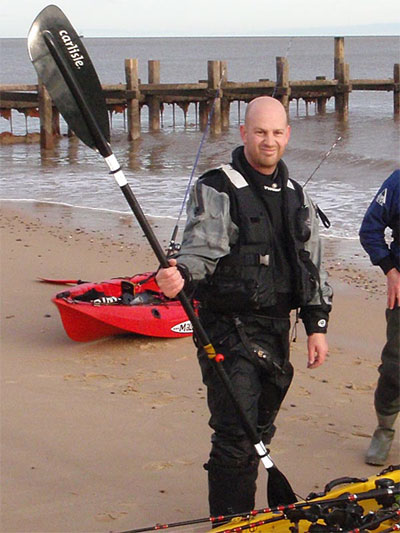
The Multisport Pro is listed by Typhoon on their website with the following text:
“Originally designed for the Paddlesports market the Multisport has carved out a huge following amongst people from a whole variety of different disciplines who are looking for a high performance, robust, back zip suit.” This doesn’t really say a great deal about the suit itself but for our use the first line is key: ‘Designed for the Paddlesports market’…
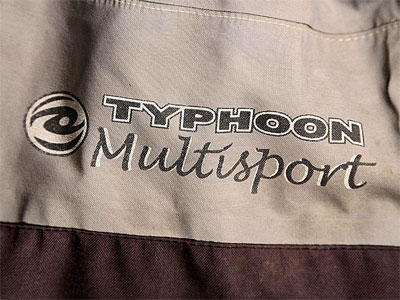
My previous drysuit was an old, non-breathable one with a front zip and while still perfectly useable it is noticeably outclassed by modern materials and designs in both the performance and comfort stakes. I shall refer to it comparatively throughout the review as it is the only one I’ve used but please note that it would also be outclassed by other modern suit designs.
The first thing that I noticed when removing the Multisport from its bag was the weight – or rather the lack of it. Weighing in at around half that of my former suit it became immediately apparent that this was going to be something far more advanced. The material used, a ‘quad ply breathable fabric’, is also soft and pliable and for somebody intending to sit in it for hours at a time this is important. It is also important for anglers to have the flexibility of a softer material and here the Typhoon has an additional design characteristic – the arms and legs are cut to provide a natural bend so that whilst paddling it is not necessary to flex against the suit itself. This increases comfort and reduces rubbing, both of which reduce the amount of unnecessary fiddling that detract from the session.
The next intentional design feature addressed by the material is in the knees and seat. These areas both see extra pressure applied by paddlers (although the knees are more of an issue for sit-inside kayakers than ourselves, bracing as they do against the interior of the kayak) and so they are reinforced with cordura to be more hardwearing. A positive side effect of this is in giving an additional layer of protection against the water where you are constantly pushing onto it.


The next area of interest is in the adjustable external waist tube. Basically, this is a layer of drysuit that fits around the midriff. This is, I believe, designed to go over a spray deck; however this is irrelevant for Sit on Top users which form the bulk of the kayak angling sector and something I cannot comment upon. Personally, however, I’m very glad it’s there as it provides an extra layer of thermal protection around the kidneys and abdomen without bulking up arms or legs (which in turn would restrict movement). It also provides an area to quickly stow items out of the way in a semi-protected ‘pocket’ while keeping them easily accessible. Security when doing this is provided by the Velcro flaps which are designed for a different purpose…

I’m an odd shape; my back is long and my legs are short. This meant that it was necessary for me to get a size to suit the largest area and so the bottom half of the suit is oversized and leaves me in danger of resembling a German Cavalry Officer in riding breeches! This is where the Velcro flaps around the central tube come into play – the tube pulls over the excess and is snugged down with the flaps keeping everything tight and out of the way. They also allow the waistline to be tightened to give that perfect hour glass figure when displaying your catch!
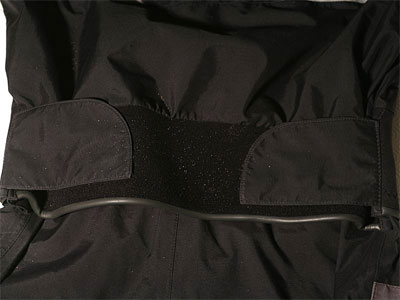
The Velcro flap idea is also used elsewhere. Going back to the pre-bent arms and legs, there is always an element of length difference on arms to be accounted for and this is of more importance on a garment that can’t be buttoned down (as with a shirt). Latex wrists are used to seal the arms to the wrists and ensure internal dryness but this leaves a flap of overhanging material that could prove annoying when paddling or holding a fishing rod. This loose flap is eliminated by securing the Velcro cuffs around the wrist and this provides an extra element of protection in the event that the latex seal is damaged.

The flap idea is also used at the ankle to tighten the suit around the sewn-in fabric socks, taking up slack from them and from the bottom of the leg and again supplying an extra seal in case of leakage.


The fabric socks themselves are interesting. My previous drysuit had latex ones which were great at keeping water out but were otherwise a complete nightmare. Latex is naturally quite tight so circulation is reduced which leads to colder feet. It’s also difficult to pull on over thick socks and even more so to pull off after a day’s fishing…with extra pairs of socks being worn in the middle of winter it really was the cause of some annoyance to me. Here the fabric socks come into their own. Socks is perhaps a misnomer as they are in fact great big cloth sacks! An exaggeration, but they are certainly large enough that I’ve always managed to have space around as many pairs of socks as I’ve put on. This doesn’t compromise the circulation or restrict movement and gives an all-weather versatility that is important to me. The downside of the socks is that when I then put them into my paddling boots they crease up initially. This, however, sorts itself out within a few steps as it finds its own place and comfort is returned. The socks are waterproof too and this is of major benefit in winter. The material on them seems to be hardwearing but I do make a point not to walk around with nothing over them as they could soon be worn down.
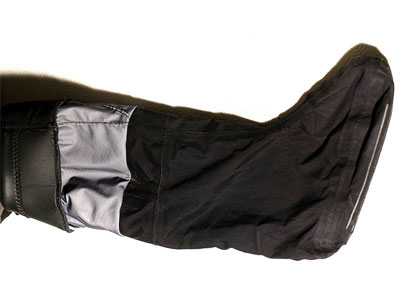

At the other end Typhoon have gone for a double seal again. The latex neck gives a watertight seal which I have yet to compromise in use (and believe me I’ve tried!) and this is added to by a neoprene collar that seals with Velcro. This is a secondary seal and would prove beneficial if the latex one was damaged but otherwise it does not seem to have a purpose that I have found. It is possible that it allows the latex to be removed for those who prefer a neoprene neck and were I to only use my drysuit for fishing or touring I would consider this but as I use it for surf kayaking as well and end up submersed frequently the latex is a necessity for me. The latex has rings moulded in that can be used as a guide to cut the neck wider for those with enough courage to do so – personally I tend to put up with the occasional headaches!

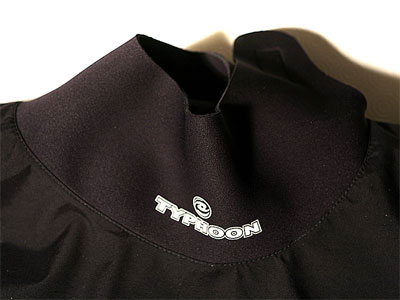
There is always much debate on drysuit zips. Front zip? Back zip? What to choose? Front zips allow an individual to dress and undress themselves with ease whereas traditional back zips often require a second person to assist in undoing it. So a front zip is surely the best option? Well, not quite…it tends to bulk up the front of the suit and is quite cumbersome, getting in the way when paddling or fishing…so what to choose?
On the Multisport Pro Typhoon designed in a curved zip running across the shoulders. This is an area where the bulk of a zip is less important as it will only ever be behind you, only in contact with a buoyancy aid and because of the nature of entry (ie feet first) it allows the zip length to be reduced. Also, being curved and finishing where it does the zip can be accessed at either end both from above and below the arm with ease, making unzipping easy.

The smooth running zip itself is a sealed, high performance two-way pressure seal BDM zip manufactured from nickel silver with aluminium bronze alloy sliders. These are serious zips with a serious reputation, built to last and used in all manner of high-end applications.
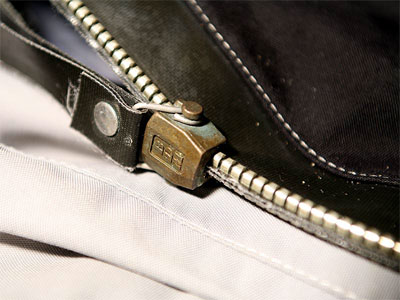
There is also the further option of a relief zip available (at extra cost) which is again of the same quality. There is not much to say about it other than it’s in the right place and easy to use…just don’t forget to lubricate it as a seized zip when out at sea and needing to use it is not as funny as it sounds!

Inside the suit there are more features. The most prominent is a set of internal braces which can be hooked over your shoulders to hold the suit in place correctly, both when fastened up in use on the water and when walking around with the top down; saving the wearer from tying the arms around their waist. These attach to rings inside the suit – although I removed mine early on.
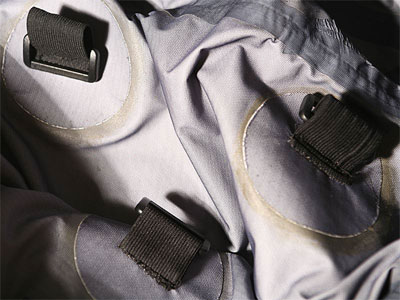
Theoretically less important is the styling and ‘look’ of the suit. Vanity IS a relevant human issue and clearly Typhoon know this…and the Multisport Pro looks GOOD. Available in grey and black with white branding it looks good both on the peg and when in use…perfect for the tackle tarts amongst us!

The features and outside have been described fully – so what about inside the suit? A different fabric lines the suit and all seams are taped which avoids any leakage from needle holes in the manufacturing process and this also extends to the interior of the socks, as seen above.

So, that is what the suit consists of; this can all be seen by looking at one in a shop. Adding the free three year warranty to the deal points out the belief in the quality of the material and adds another layer of interest but the important thing is how it performs in use and so let’s describe a typical outing…
The alarm goes and I get out of bed. A pair of Typhoon underfleeces and a thick pair of socks go on and I’m downstairs for a quick coffee before heading to the beach. At the door I slip into my Multisport, braces over my shoulders and the rest around my waist and slip on my neoprene paddling boots having secured the neoprene cuffs around my ankles. The socks scrunch up inside them and so I flex my feet and walk out to the van; the socks have settled by the time I get to the front gate. Into the van and the suit wells around my midriff. The light material doesn’t create too much bulk and driving is not at all uncomfortable even with the seatbelt over it.
Arriving at the launch point I hop out, unstrap the kayak and lift it off the roof, load it up and trolley it down to the water’s edge. Once it’s prepared for launch I put the drysuit on fully. With my arms pushed down the sleeves and out through the latex cuffs I bring the suit body up and lift the neck over my head. A bit of pressure and my head pops through, ensuring that the latex is laying flat to keep it from being overtight and causing discomfort on the water. The next stage is to close the suit, and reaching over my shoulder I take hold of the zip tag and pull it across to the other side, swapping hands to ensure it is fully closed. Squatting down with my fingers in the neck seal I release some of the trapped air and stand up again. The neoprene cuffs are then sealed in a comfortable position and finally I roll the neoprene neck seal into a more comfortable position. Really, the one major annoyance of this suit for me is the neoprene neck seal; no matter what I do I can never get it comfortable and try folding it, rolling it, tucking it under – short of cutting it off I don’t think I’ll ever get around it. I certainly can’t abide it in the up position! The final operation of getting kitted up is key to much of my comfort over the next few hours; I undo the Velcro waist flaps, pull up the suit’s legs and secure the flaps tightly. And then it’s into the water.
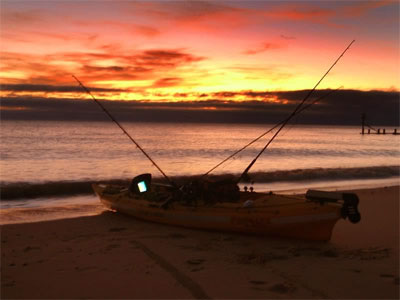
The procedure is the same irrespective of whether I am heading out on one of my fishing kayaks or if I’m taking the Yak Board out for some surfing. Both require a suit that will remain comfortable and keep me dry but the latter gives it more of a workout. It also requires more of a streamlined shape and so I tend to make the final alterations the first time I fall off…by allowing the water pressure to squeeze out more trapped air by opening the neck seal with two fingers, this increasing my flexibility for controlling the kayak or for swimming if I lose it on a wave. I don’t release so much air when fishing however as the excess warms up slightly as well as giving some added buoyancy.
After a few hours on the water the morning coffee reminds me of its presence and at this point the convenience zip is regarded as a great asset! The technique – forgive me – is to lean way back, undo the zip – so far so good - and then fish about inside the underfleece to find the necessary plumbing. This is where it gets difficult. The zip on the drysuit is perfectly positioned but on the underfleece it doesn’t come down far enough and a degree of flexibility, some choice words and a lot of luck are required to actually be able to make use of the zip. I’ve even tried it standing up on land and it involves contortions that would have me pass interviews for jobs in the circus! So, I’m lying back, leg over the side and aiming for the front scupper hole…it works and I’m relieved.
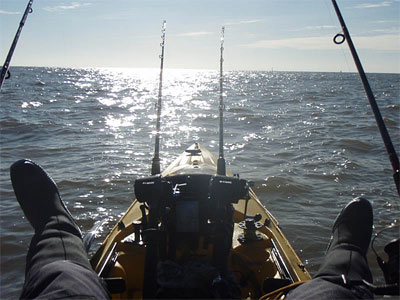
Coming off the water at the end of the session and the zip is undone by reaching over my shoulder again; I pull my head out, then the arms, then sit down and remove my boots. Unstrapping the ankle tabs I step out of the boots (without having to stand on the toes and stretch them which was the way with latex) and it’s into the back of the van.
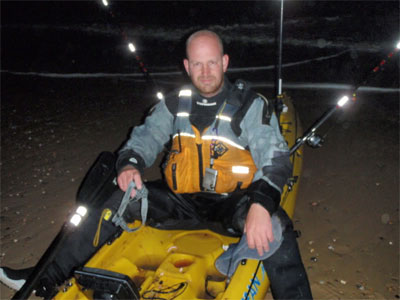
Now for observations on what it is actually like from a wearer’s point of view. This is a membrane drysuit so there are no real thermal insulating properties. This allows the suit to be worn in warm weather without the risk of overheating and dehydrating or as a shell layer in winter. As I wear a drysuit principally as a safety item the ability to wear it year-round is vital – I am dressing for water temperature rather than air temperature and this is my insurance for if I go in and get separated from my kayak. It is there to keep me alive. As an idea of typical water temperature where I live 16 degrees is the highest it is likely to get in the middle of summer. That’s unconsciousness in 1-2 hours and an expected time of survival of 1-6 hours. The drysuit with nothing underneath will aid survival by keeping the moving water off the skin and only the temperature needs to be considered – add a thin base layer beneath it and chances of survival are improved. Come the winter time and my two or three layers - that remain dry – are going to keep me alive hopefully long enough to be rescued if the worst happens.
http://www.westpacmarine.com/samples/hypothermia_chart.asp
So, beneath the drysuit I can dress suitably for conditions and my clothing will remain dry. It’s not going to make me hot on its own but when paddling I am exerting myself physically and therefore can reasonably expect to sweat. Fortunately the Multisport is also breathable and while not all sweat will escape on a hard slog I certainly come out feeling drier (and therefore warmer) than I did in my old suit. Kayak surfing makes me damper from the extra effort but gone are the days of actually feeling wet when I peel off the drysuit. There also is more than enough flexibility in the material and cut to turn into the stroke, fling myself forwards or backwards and move my arms quick enough to get onto a wave.

Speaking of surfing with it, it holds up very well for this. I tend to go out in the sort of churned up mess that sees me going into the water from all directions, including headfirst, on at least half of my attempts to get out through the waves and I’ve yet to notice any water coming in through the neck or wrist seals or forcing its way through the zips. This is rather an extreme test for a surface drysuit as it is like being in a washing machine at times and I can honestly say it comes through it with flying colours. Of course this is to be expected as Typhoon have been making drysuits for many years and diving exerts a lot more pressure on suits than playing in surf so I wouldn’t expect any leakage from seals.

I don’t think there’s a lot more I can say about the suit in use really other than to keep the zips lubricated so they’ll run smoothly, rinse it off now and again to stop it stinking of rotten fish and put some talc on the latex for an easier entry…The problem is it’s as difficult to appear impartial with something you haven’t paid for as it is with something you’ve paid loads for so reviews like this that are full of glowing praise often need to be tempered with that thought. I do try to be honest and paint as full a picture as I can, putting in the negatives as well as the positives but there is little to pull this suit up on.
I could of course say that if it was rubbish, or not up to the demands I put onto my gear then I wouldn’t use it…but I probably would as I put up with most things. The fact is though the Typhoon Multisport Pro IS good, and as such I have recommended it to a lot of people, most notably two of my regular fishing partners who would perhaps fillet me if I’d wasted their hard-earned money. That answers the question of whether I’d recommend it but the main question is whether I’d buy one myself…the answer is that yes, I would.
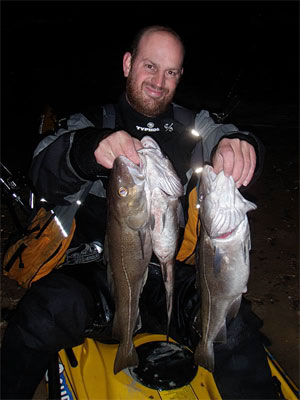
Addendum
This is all good knowledge about what the suit is and what it does, how well it does it and how comfortable it is but with any review, no matter what length of time it is done over, some things get missed out. Most notable of these is the question of what happens if things go wrong. So what does happen?
While finishing this review off I started to notice that I was getting a damp left leg. Not wet, just damp. I had a look at the suit and couldn’t see anything obvious such as a tear (perhaps during re-entry or bouncing off the bottom in surf for example) nor could I see a puncture (for example from a hook or stone) or even some torn threads. Being a breathable suit I wondered if it may have been down to a blocked pore or something, which can happen, so gave the suit a good rinse and left it to dry before using it again. Unfortunately, after a long session on the water (and standing in the surf for a few minutes to rinse stray bits of dead sea creatures off myself) I again noticed the dampness. I confirmed this on the next session and so took the decision to send it back to Typhoon.
I telephoned their office and the call was answered promptly by a courteous and helpful lady on the front desk who then put me through to the right department – a gentleman by the name of Billy who told me to send it in and he’d take a look. This I did with a covering letter also apologizing for the suit smelling of fish!
The day after it arrived with Typhoon I had a call from Billy. Unfortunately my suit was beyond repair and would have to be replaced. There was no argument about lack of receipt, age of the suit, care and maintenance or lack of it, wear and tear, heavy use etc, nothing. Typhoon gives a THREE YEAR warranty on their drysuits and they honour it. My suit would be replaced with a new one and in this case (because of the timing) with their new model that is about to be launched (once stocks arrive). I did, in my opinion, receive excellent customer service from Typhoon (without them knowing that it was a review suit or that I was doing a review) and the knowledge that I would be covered for three years would certainly be a major consideration for me if buying one of their products in the future.
